The OB-8 is a clear recommendation for all who are looking for that characteristic – and up to now nearly unachievable – analog sound of the late 70s and early 80s. Today, classic analog poly-synthesizers clearly indicate that a major chapter in synthesizer evolution is now closing – slowly, but surely.
The thing is: you can talk about classical vintage synthesizers, you can closely analyze their remarkable concepts and praise their unrivalled sound … but what’s that all good for if those objects of keen desire are no longer available? Most classic synthesizers have found a permanent home these days. Studios and collectors all around the globe are in the picture as to the musical and financial value of the instruments. No wonder classic synths are rarely sold nowadays!
The vintage synth market has been swept clean, unless you count that playground of traders and opportunity hunters who continue to keep the market simmering with utopian price expectations – assuming the instruments are available at all! Memorymoog? Barely obtainable outside the USA. Yamaha CS-80? Nada! Rhodes Chroma? Long time no see. Roland Jupiter-8? Very rare and veeeery expensive. (Right now, early 2022, there are a few units available at reverb.com – for approx. 30,000 Euros / USD a throw.)
So … what about the Oberheim OB-8? Well, this classic still turns up with some regularity. And it’s still affordable – current OB-8 prices range somewhere between 6,000 Euros/USD (January 2022) and 11,000 Euros/USD (July 2022). Almost by coincidence, this is also one of the best vintage Oberheim synthesizers – possibly one of the best vintage polyphonic synths ever built. And although the new Oberheim (DSI) OB-6 is highly esteemed and – quite rightly – much praised, its sound is different. Seems as if the classic vintage vibe – a slow drifting sound full of beats – is impossible to copy.
OB-8 – the synth guru’s beloved Oberheim …
My personal story with the OB-8 begins with Juergen Haible. When I was paying him a visit at the turn of the millenium, Haible offered me a tour through his laboratory, his sacred hall of mysterious instruments.
And there they were, those fabulous synth-clones that Haible had built himself: JH-720 / Korg MS-20 Clone, JH Synthi Clone, JH Midi Mini, the JH-3 modular system. Along with other gems like the JH-3100 resonators, the JH HiFli / EMS Clone, a replica of the ARP Quadra phaser.
Alongside all DIY projects, for which Juergen Haible had gained worldwide fame, there were also some original classic synthesizers in his laboratory. Like the Yamaha CS-50. Or the Oberheim OB-8. And Juergen Haible surprisedly avowed that THIS – the OB-8 – was his favorite Oberheim synthesizer.
“I did not intend to buy an OB-8 when I was looking for a “real” analogue polysynth some years ago. When I was a student, I could only afford digital emulations of analogue sounds (on a Kawai K1 or Roland D50), or an analog/digital hybrid like the Ensoniq ESQ1. Then, when I got a job, I was looking for the “real thing”, and that was, by then, a Prophet-5.
Then I saw this almost new OB-8 at a local dealer’s, at about the same price as a Prophet. I was offered to take it home and test it for a week or two, and that was when I fell in love with this synthesizer. I forgot the Prophet, bought the Oberheim, and did never regret it.”
(Source: http://jhaible.com)
I kept those words secretly stored in my brain, until – by accident, and 10 years later – an OB-8 was offered for sale in a local town just around the corner. I bought it immediately. And it’s still in my studio.
Today – another 10 years along the line – I have to admit: Juergen Haible was right. The OB-8 is one of the best (vintage) polyphonic synthesizers. Personally, I thinks it’s the peak of the polyphonic OB-Series, the cream of the crop.
Ok, ok, its predecessors were also premium instruments as well. The massive sound and radical power of an OB-X is unsurpassed. And the OB-Xa has written synthesizer history! But taken as a whole, the OB-8 is at the forefront, with its noble sound, factory MIDI, fine-to-the-feel keyboard and “tricky” software (for that extra bit of sound design) …
The features: tradition meets progress
Superficially, the OB-8 has a strictly classic (analog) synth design. It is a 120-memory, split/layer 8-voice machine. Each of its 8 voices offers:
- 2x VCO (Saw / Pulse + PWM / Triangle)
- 2x ENV (ADSR, for VCF and VCA)
- 1x VCF (12dB 2-Pol / 24dB 4-Pol)
- 1x VCA
Then there are two Low Frequency Oscillators:
- Main LFO (Triangle / Rectangular / Saw Up / Saw Down / Sample & Hold)
- Performance-LFO (Triangle / Rectangular / Saw Up / Saw Down / Noise / Sample & Hold)
Since the OB-8 has DOUBLE / SPLIT mode, there are actually 3 (!) Low Frequency Oscillators (two Main LFOs and one Performance LFO).
Global features / controllers:
- HOLD function
- CHORD function
- Portamento / Glissando
- Oberheim Levers (pitchbend / modulation)
- Arpeggiator (plus Arp transpose memories)
x - SPLIT Mode (with lots of extras)
- DOUBLE Mode (with lots of extras)
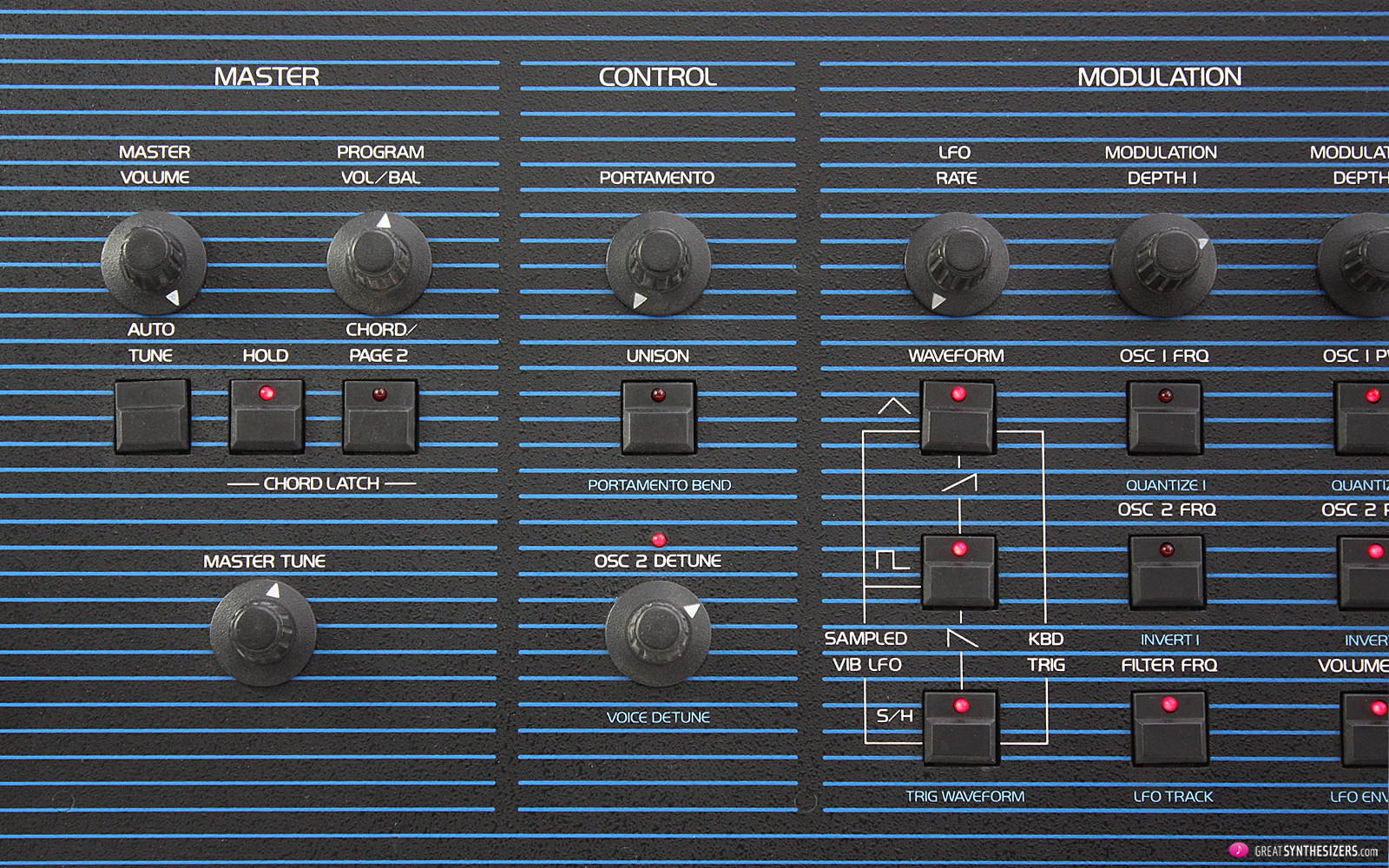 Pic.: Master-area with Portamento / Unison and VCO2/Unison Detune.
Pic.: Master-area with Portamento / Unison and VCO2/Unison Detune.
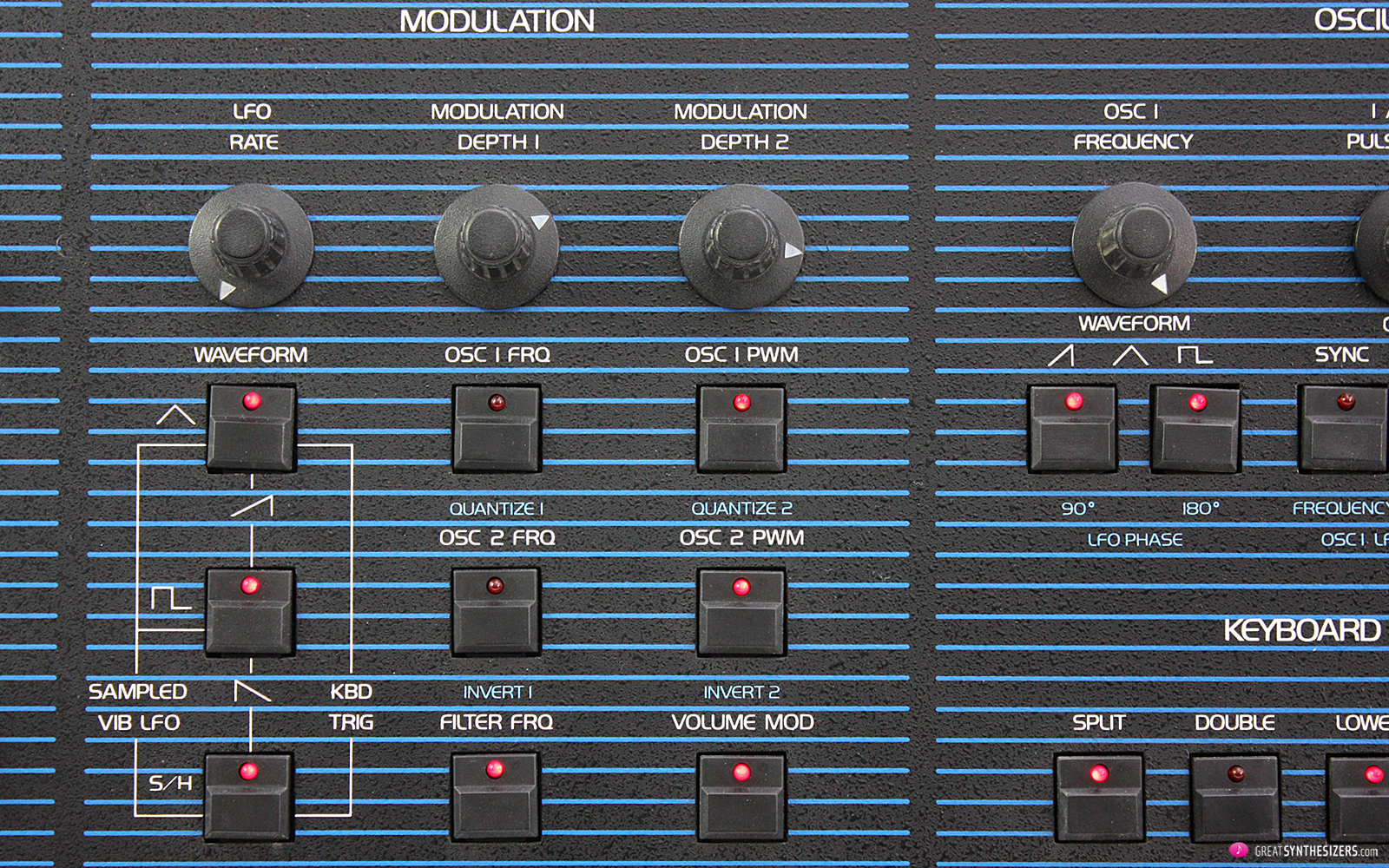 Pic.: LFO with lots of waveforms and two (separate) modulation busses
Pic.: LFO with lots of waveforms and two (separate) modulation busses
 Pic.: VCO 1 / VCO 2, Osc-Sync and Filter-Envelope Control (of VCO 2)
Pic.: VCO 1 / VCO 2, Osc-Sync and Filter-Envelope Control (of VCO 2)
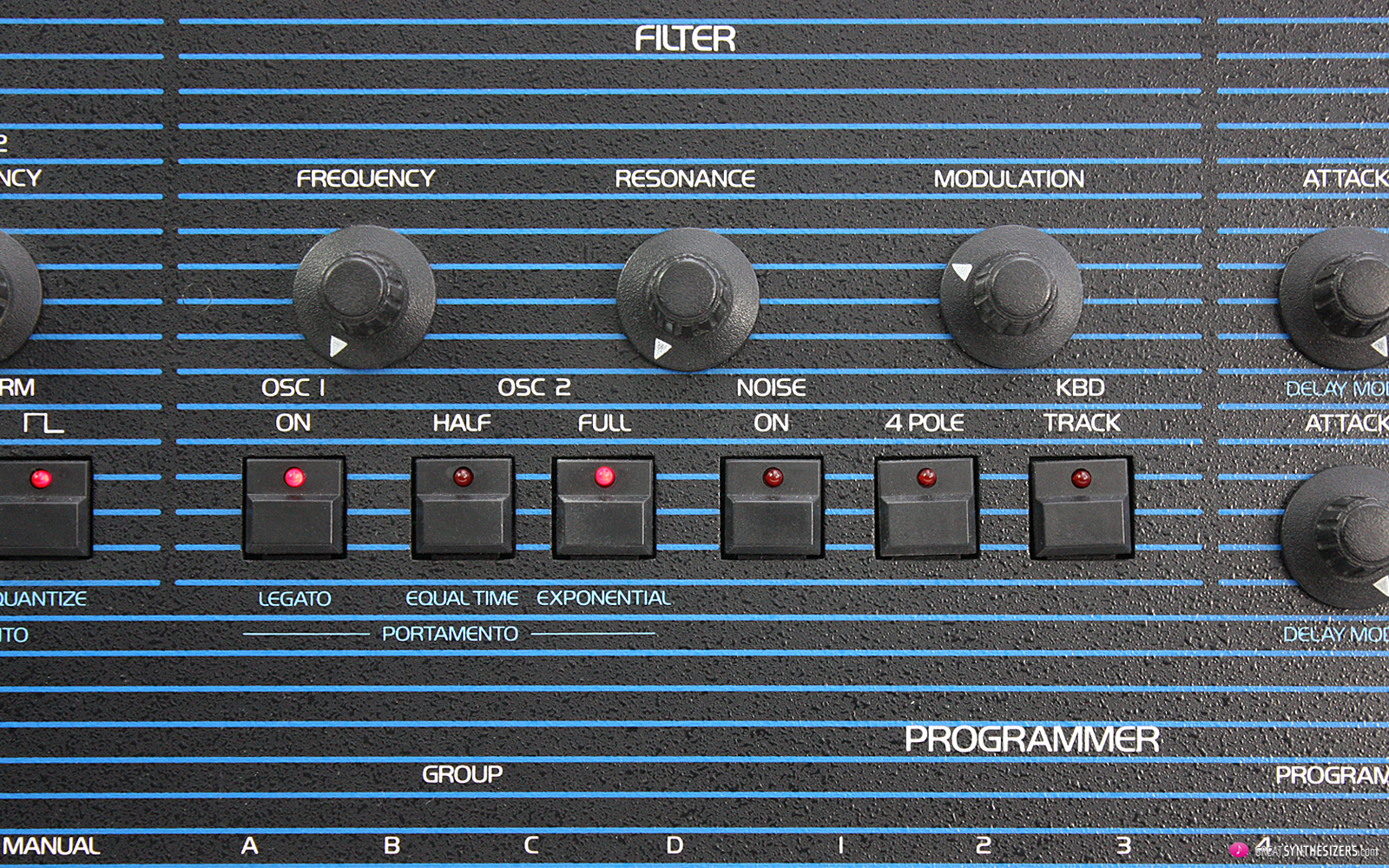 Pic.: Filter and simple Mixer (VCOs on/off, Noise) in one …
Pic.: Filter and simple Mixer (VCOs on/off, Noise) in one …
 Pic.: ADSR for VCF and VCA, plus Delay-Attack envelopes (PAGE 2)
Pic.: ADSR for VCF and VCA, plus Delay-Attack envelopes (PAGE 2)
Now, these features would seem to be quite ordinary. Nothing really special, right? However, an important part of the OB-8 lies tucked under its bonnet. This brings us back to those light blue labels – to all those glorious PAGE 2 functions. Keyword “tricky” software.
PAGE 2 offers among other things the following double assignments:
- 2 separate Delay-Attack envelopes for the LFO mod busses MOD 1 and MOD 2
- Quantizing and Inverting of LFO waveforms
- LFO phase by 90° / 180° which offsets the LFO phase of voices 5-8 relative to voices 1-4: stereo images possible with a single LFO …
- Inverting of LFO modulation depht of VCO 1
- LFO Tracking via Keyboard – the LFO speed double with every 4 octaves of the keyboard
- VCO Detune (Unison-Mode)
- Various Portamento-Modes (Match, Quantize = Glissando, Legato, Equal Time, Exponential)
- Portamento Bend (= Auto Bend, programmable)
- MIDI Functions (Prg. enable, Bend/Mod enable, Omni on/off, Channel Select)
Incidentally, there is another area of the OB-8 with double assignments. Pressing ARPEGGIATOR (ON) in the controller section turns most of those switches into dedicated arpeggiator controls.
Granted, not all that glitters is gold. Some functions of the OB-8 are difficult to understand. Often, the user manual isn’t any big help at all. A brief example …
Chord and Arpeggiator Portamento: “Held Chords being transposed will not portamento if the PORTAMENTO BEND is on. Notes being Arpeggiated operate in the opposite manner: they will portamento only if the PORTAMENTO BEND is on. So, when using portamento with Held Chords that are being transposed and Arpeggiated, you have a choice: With the PORTAMENTO BEND on, each arpeggiated note will portamento; with the PORTAMENTO BEND off, only the chord transpositions will portamento.”
(OB-8 User Manual, page 36 / page 40)
At some point, after reading the paragraph five or six times, you might get an idea of what’s going on here. But in the end, some double assignments and their functionality possibly remain a challenge. Nevertheless, PAGE 2 is a boon to the sound designer. A true “gem”.
MIDI – simple, but sufficient
Factory MIDI is a blessing. I wrote that as a small rule of thumb in my diary. Sure: modern MIDI kits are “very” useful – Kenton Electronics and Encore Electronics offer excellent retrofit kits for many vintage polyphonic synthesizers. Nevertheless: If original factory MIDI is available, I would always tend towards that solution. Although the scope of performance may be pitifully low, factory MIDI creates a clear unity with the instrument. No modification is necessary, the system remains self-contained and – generally – stable.
As expected, MIDI on the OB-8 is simply basic. NOTE ON/OFF, PROGRAM CHANGE and PITCH BEND/MOD WHEEL data is sent / recognized. In addition, sounds can be sent via MIDI dump from one OB-8 to another. “Sound per sound”, one after the other … I’d assume roughly 120 sounds in ten minutes. And of course you have access to the desired MIDI channel. And that’s it.
 Pic.: Connections – Audio (Left / Mono / Right)
Pic.: Connections – Audio (Left / Mono / Right)
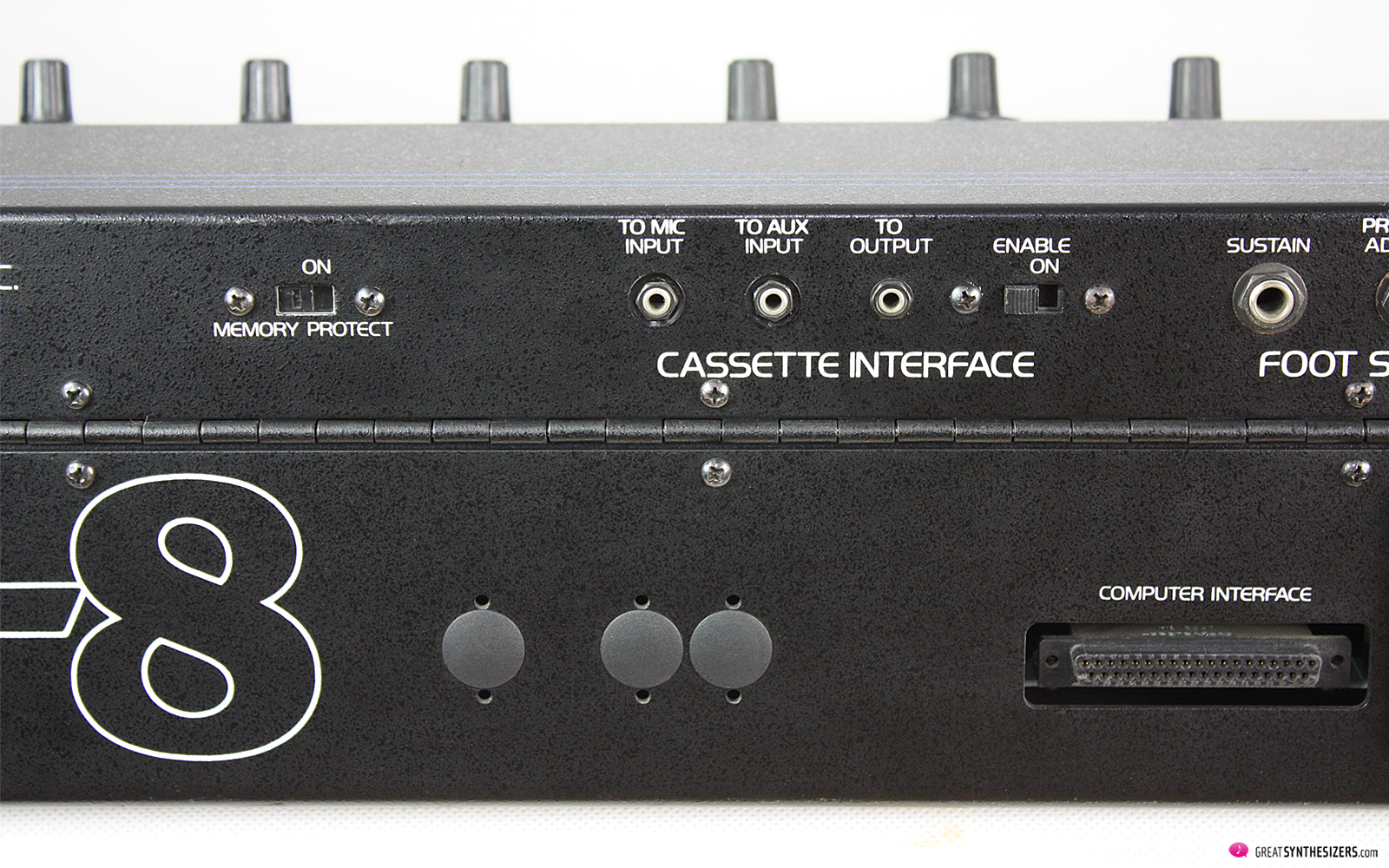 Pic.: Connections – Cassette Interface and Computer Interface (Oberheim System)
Pic.: Connections – Cassette Interface and Computer Interface (Oberheim System)
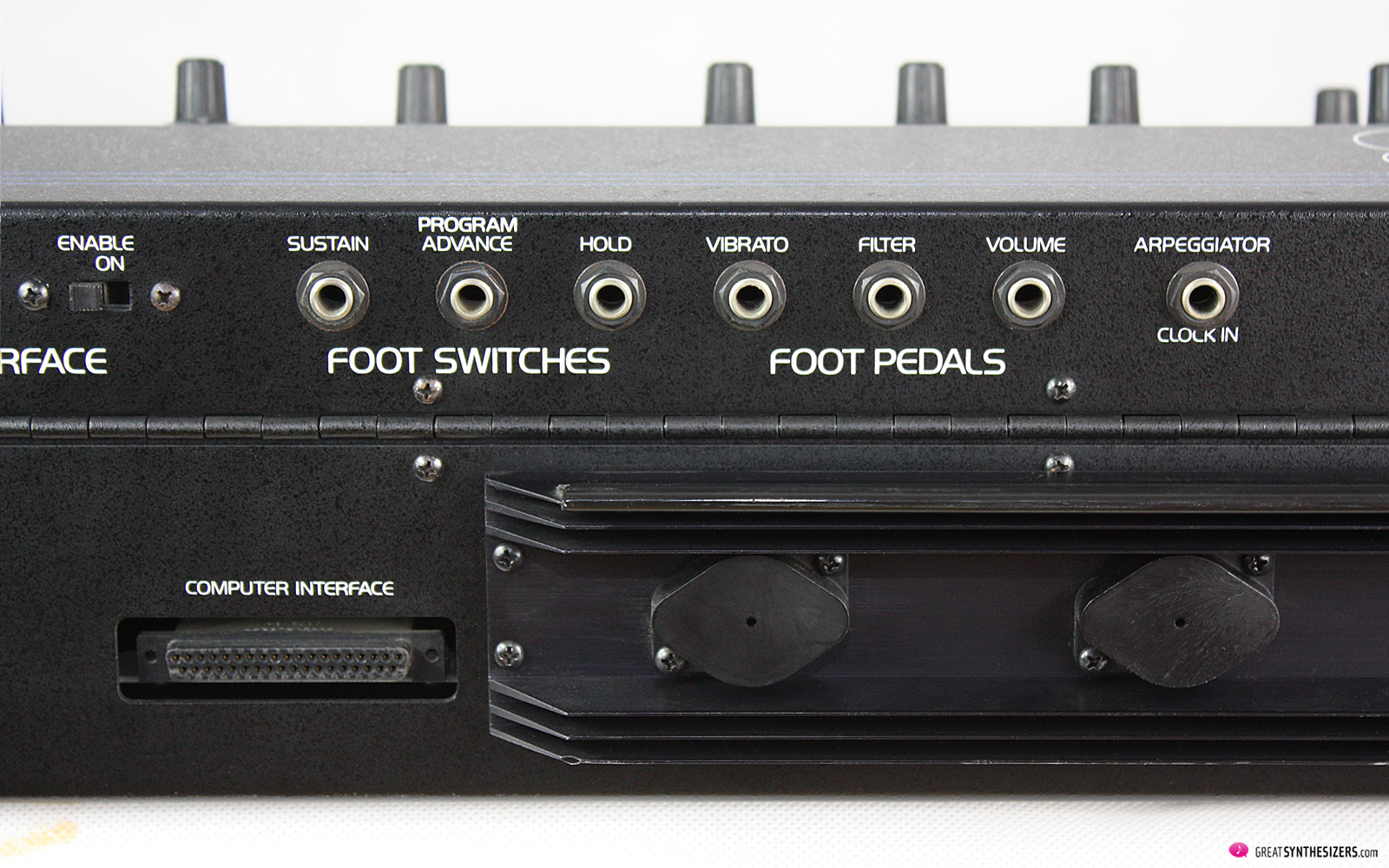 Pic.: Connections – Foot Switches, Foot (CV) Pedals and ARP Clock IN
Pic.: Connections – Foot Switches, Foot (CV) Pedals and ARP Clock IN
The SOUND: excellent – with some modifications even better
Admittedly, technical details can be boring. Of course an Oberheim synthesizer from the early 80’s has 2 VCOs per voice and connectors here and there. So let’s get on to the music. How does the OB-8 sound?
Creamy and absolutely brilliant. More specifically: a fantastic 8 voices with lively beats that constantly change direction in the stereo panorama (assuming the PAN potentiometers have been accordingly set). Luxurious sound carpets, poly portamento shifts and filter sweeps – permanent cinema-sound feeling in the studio. 16-VCO-unison-lead solos – overwhelming! A few quick impressions thus far.
The OB-8 distiguishes itself from some of its competitors because: It has 8 voices (Sequential Prophet 5: 5 voices, Moog Memoyrmoog: 6 voices) and it sounds – especially in contrast to the Roland Jupiter-8 – alive and expansive, “without” the necessity of activating DOUBLE mode.
In plain text: for pad sounds of all kinds, OB-8 offers the most warmth of sound of most vintage polyphonic synthesizer (next to its brothers OB-X / OB-Xa, and possibly next to the Rhodes Chroma), even topping the new Oberheim (DSI) OB-6. However, the new OB-X8 might be a notable successor to the OB-8. Read the two-part article OB-X8: Best Oberheim ever? by Matt Vrazo to find out more …
On the other hand, the original OB-8 does have a problem with its envelopes, which tend to be a little bit sluggish. Short, percussive sounds are not one of the instrument’s strengths. In this one case, Prophet-5, Memorymoog and Jupiter-8 are a lot snappier. Problem is the mediocre factory calibration. But this can be easily fixed! Adjust your OB-8 envelopes below those sluggish factory settings and you get an instrument that is in line again with Prophet-5, Memorymoog and Jupiter-8.
Some aspects of sound design are unique in the OB-8 … key word ‘tricky software’. Phase distorted LFO modulations for further amplification of audio pan? No problem. A quarter turn (90°), a half turn (180°)? You have the choice. Unison detuning adjustment, from already massive to outrageously massive sounds? One turn – done! Increasing LFO speed according to the keyboard? Just activate LFO TRACK – and you’re done. All this is fishing in that ominous PAGE 2 pond. It’s the software that makes the difference!
Granted, the OB-8 is not the best synth for effect sounds. Its modulation routings are “ok”, but not at all special. Once more, Memorymoog, Prophet-5 and Rhodes Chroma get more points here. To say nothing of Oberheim Xpander and Matrix-12, with their powerful software / modulation matrix.
BUT … it’s the OB-8 that produces the “classic” warm, lush L.A. sound. Its liveliness and sonority can hardly be achieved with any other poly-synth. What are tons of modulation routings good for if the basic sound is sterile and (a littlebit) ordinary? I had the Xpander for many years, then sold it, and don’t miss it at all. It’s a great piece of equipment for multi-timbral purposes, for exciting sequencing … but, somehow, its basic sound character is a little boring. Tight and precise. At least, that’s what my ears tell me. No comparison to those great early Oberheim sounds …
Admittedly, the OB-8 sound is a clear step below OB-X / Xa. But Juergen Haible developed some (quite simple) modifications to bring the OB-8 up to OB-Xa standard.
The capacitor-mod in the VCF-VCA area, for instance. Or an increase in the final VCA audio quality (… here’s another link). Capacitor-mod and/or audio-mod lend the OB-8 more bass and a fundamentally stronger audio signal and – if I’m right – in filter self oscillation.
Further Haible upgrades: MultiMode VCF Modification and Poly Modulation (audio-rate filter modulation by VCO 2 … ).
Finally: The OB-8 hardware
A few surprises. First: Weight. Despite its massive size (103 x 52 x 16 cm), the OB-8 weighs a mere 17 kg. Even in a flight case, it’s quite comfortable to carry around.
Next: Those two handy recesses in the wooden side panels. One for voice panning, one for MIDI.
[ MIDI seems to have undergone a 3-stage evolution, similar to the Elka Synthex. At first, there were a few hundred OB-8 “without” MIDI. Then there was factory MIDI, implemented in the left wooden panel (and also offered as a retrofit kit for the very first units). Finally, MIDI found its way to the back of the OB-8. ]
A special highlight of the OB-8 is its excellent keyboard. Not touch-sensitive, of course, no … it’s just an excellent, well-weighted, very playable keyboard. OB-X and OB-Xa owners may raise their eyebrows here: “How can that be – an Oberheim without chunky keys?” Ah, yes – the OB-8 is a true player’s instrument …
Not exactly a surprise, but a true sensation: that luxurious OB-8 user panel. Such a clear layout with large knobs and lots of space is definitely a sensation. Pure luxury.
All in all
Looking for that earth-shattering, lively and meaty vintage sound of the late 70s / early 80s? Keep an eye out for an Oberheim OB-8. Simply one of the best sounding synthesizers ever. Modern polyphonic analog synthesizers don’t sound the same! They have their own musical qualities and their own legitimation. But they sound different – straighter, more direct, more transparent.
The OB-8, however, is like a wild animal. Untaimable. The last of its kind with that famous L.A. Sound that gave Oberheim the world-famous reputation as producer of organic-sounding / massive-sounding instruments.
Surprisingly, the OB-8 also features advanced technology. 120 memories, light-weight, a pleasant keyboard, acceptable technical reliability, MIDI, advanced (PAGE 2) functions.
Finally, unlike many other vintage classic synthesizers, the OB-8 is – as of 2022 – still available on the secondhand market. Ranging at a price between 6,000 and 11,000 Euros/USD (November 2023), this synthesizer seems to be – aside the new OB-X8 – one last opportunity to bring the aura and power of the original polyphonic vintage sound into your studio. At a – more or less – realistic price …
x
x
Soundfiles: It’s all OB-8, with the exception of the drums (Korg Minipops 120, Roland TR-808) and various synthesizers in the “Mix” soundfile (including the Korg M1 and its distinctive “Lore” sample). And an external (high-frequency) LFO was used in the “External Filter FM 1/2” soundfiles to get those special vocal sound effects. Enjoy listening.
Oberheim OB-8
Polyphonic Analog Synthesizer
with Arpeggiator and MIDI
8 Voices
Links:
Vintage Synth Explorer
Tauntek.com/OB8 (new OB firmware with MIDI CC / MIDI clock)
Download/Open:
Oberheim OB-8 Synthesizer XL photo (4300 x 2700px)
Juergen Haible Filter Mod (capacitors)
Juergen Haible Audio Mod (audio range)
Related Articles:
OB-X8: Best Oberheim ever (Part 1) by Matt Vrazo
OB-X8: Best Oberheim ever (Part 2) by Matt Vrazo
Related Reviews:
Yamaha CS-50/CS-60/CS-80 Review
Sequential Prophet-5 Review
Moog Memorymoog Review
Roland Jupiter-8 Review
Elka Synthex Review
Youtube:
OB-8 Demo by tritonrecordings


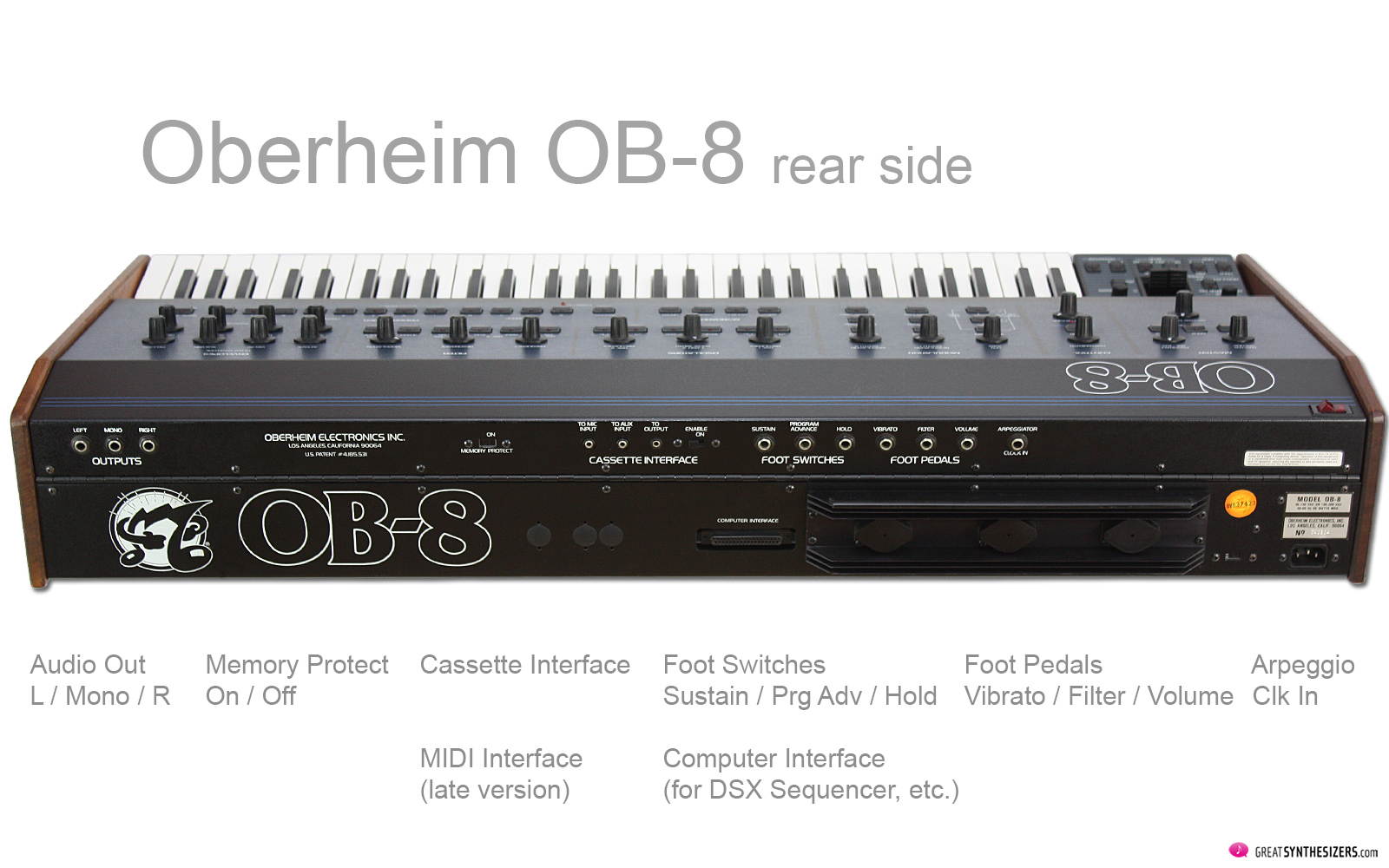
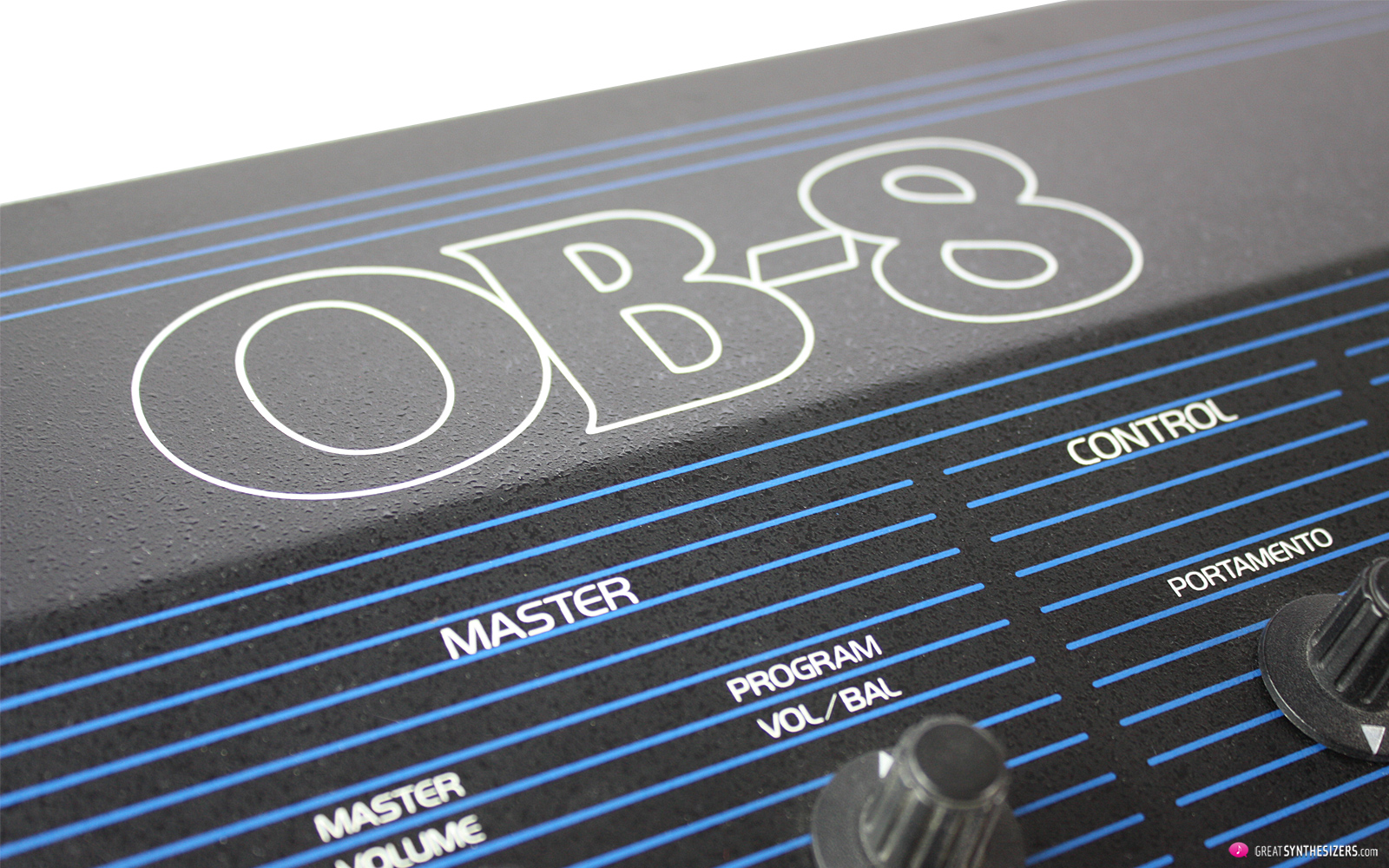

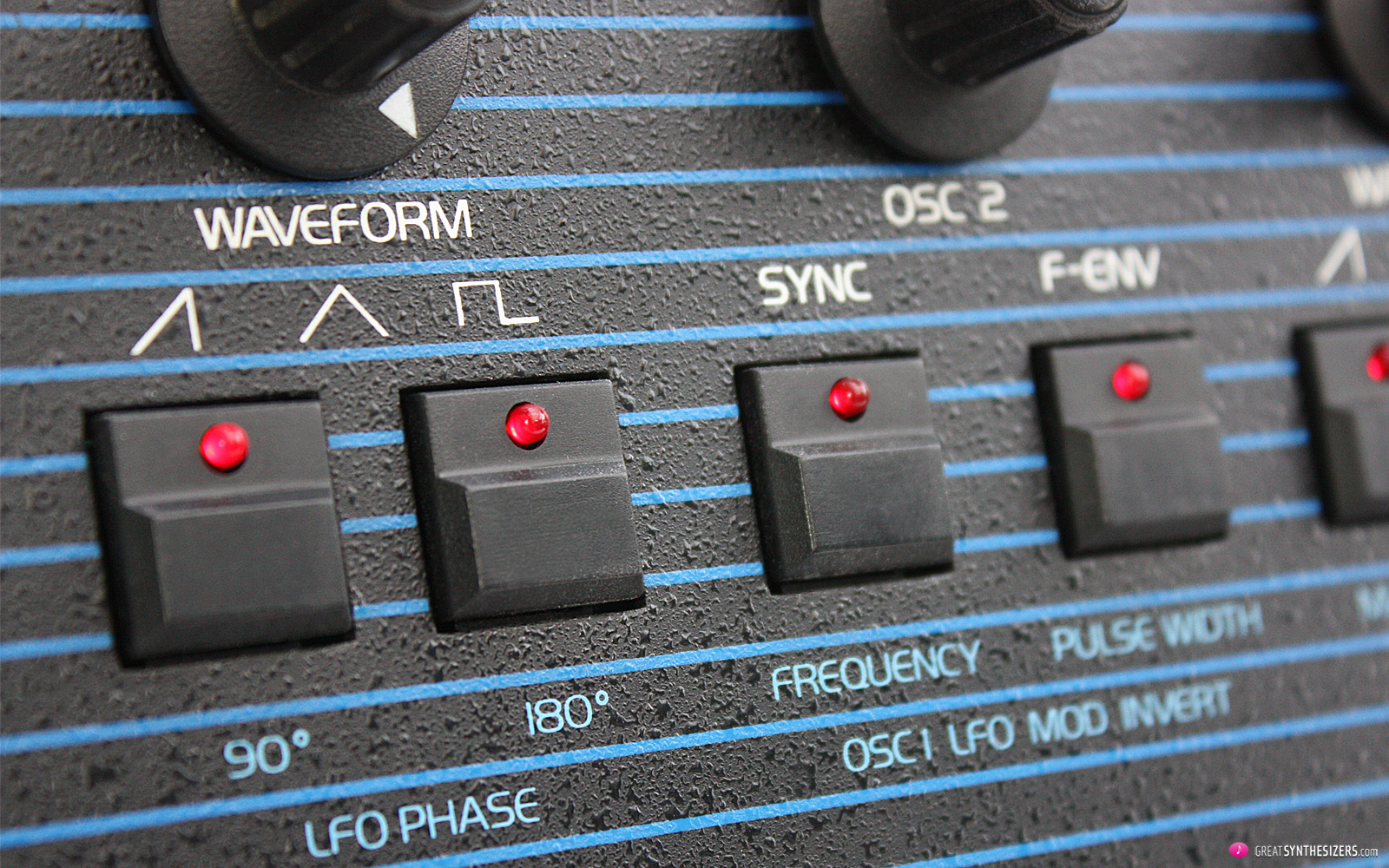
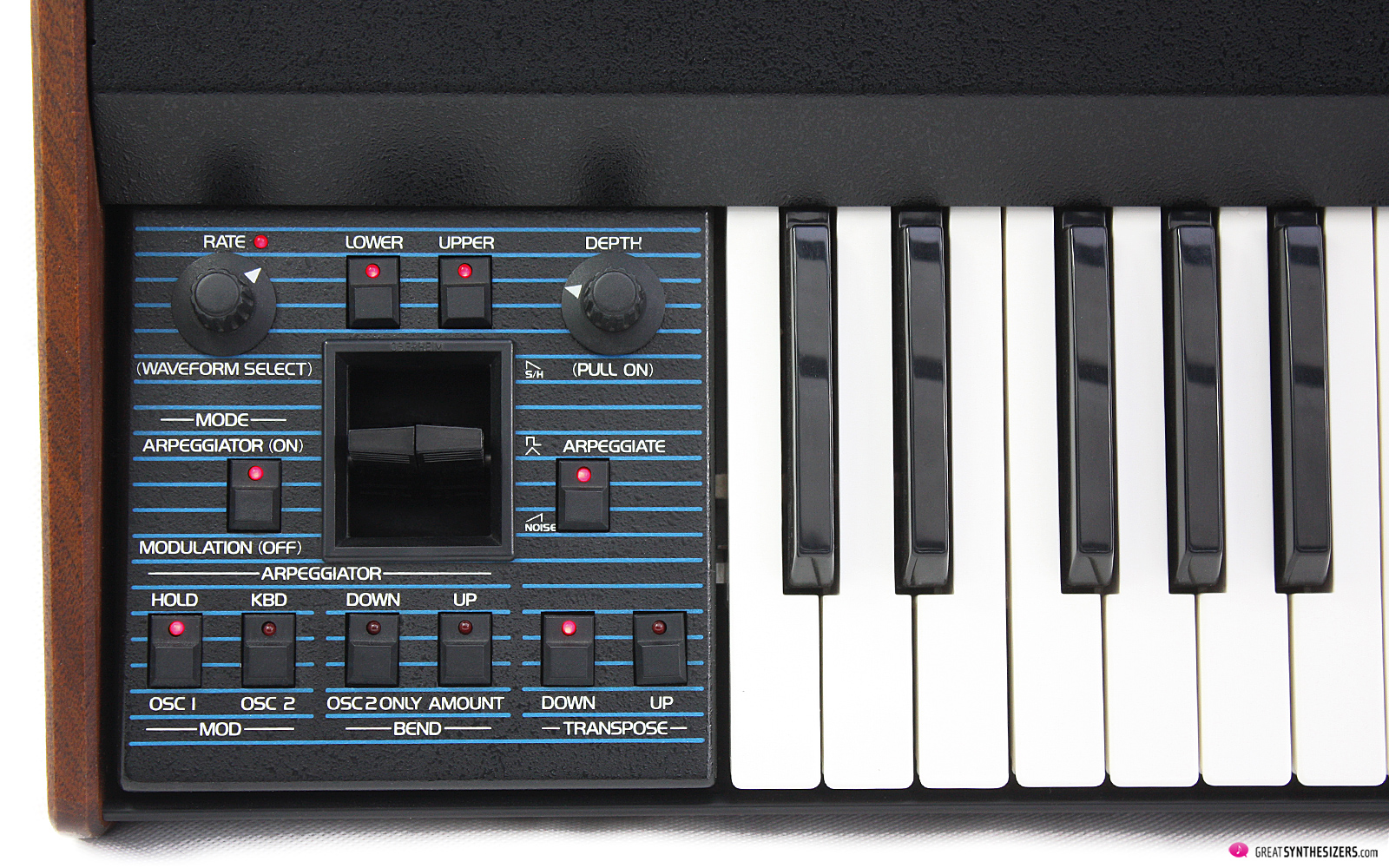
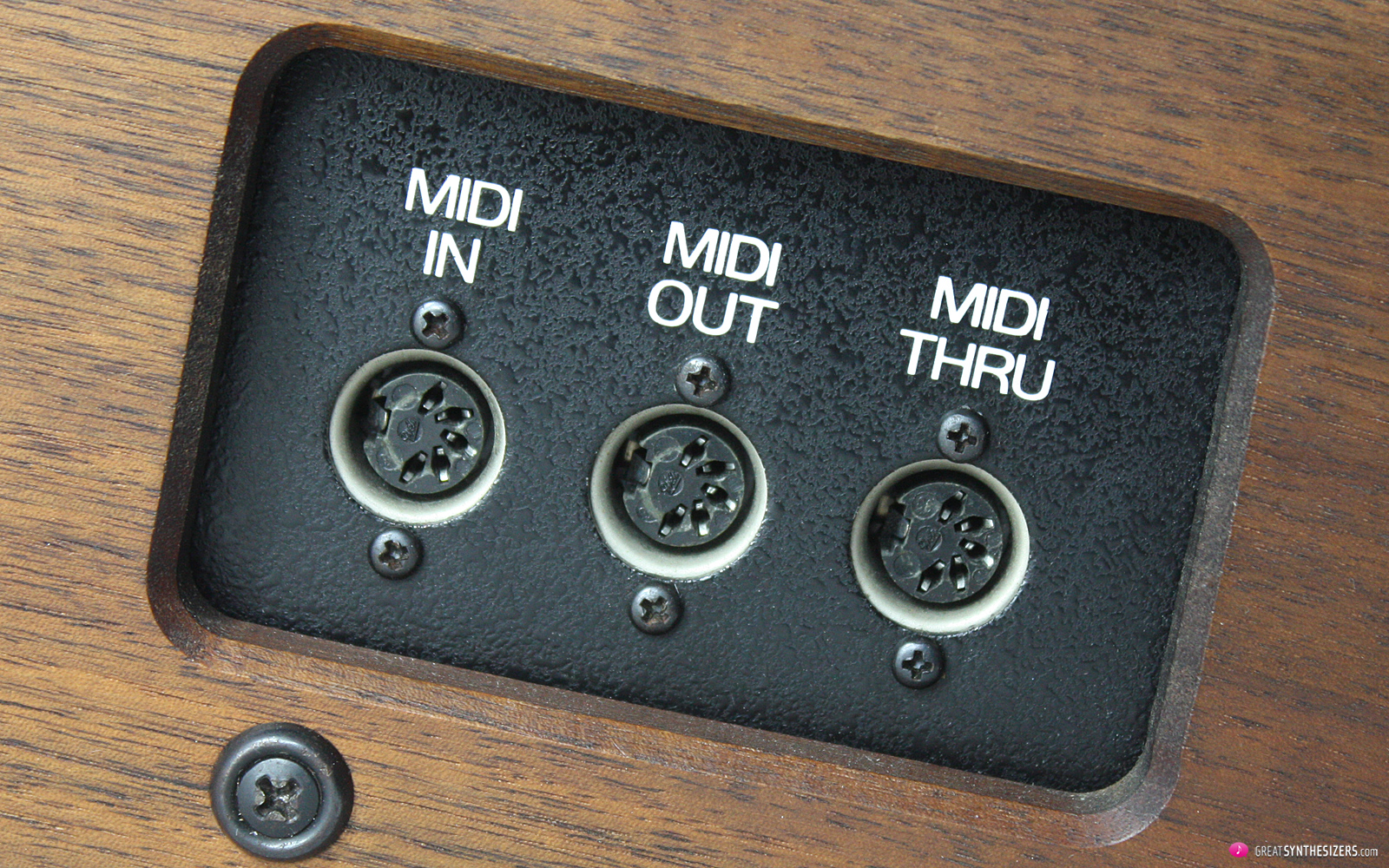
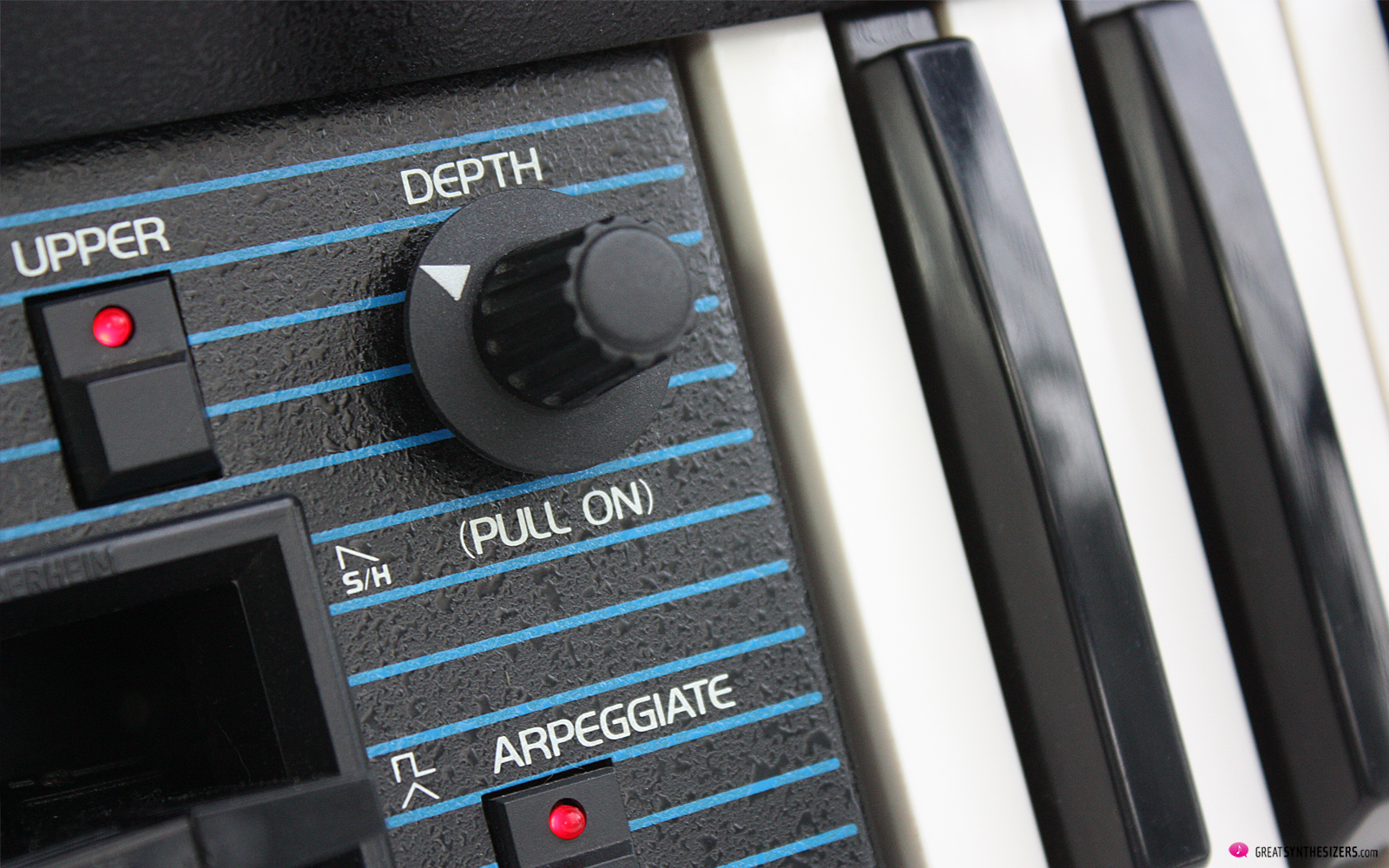
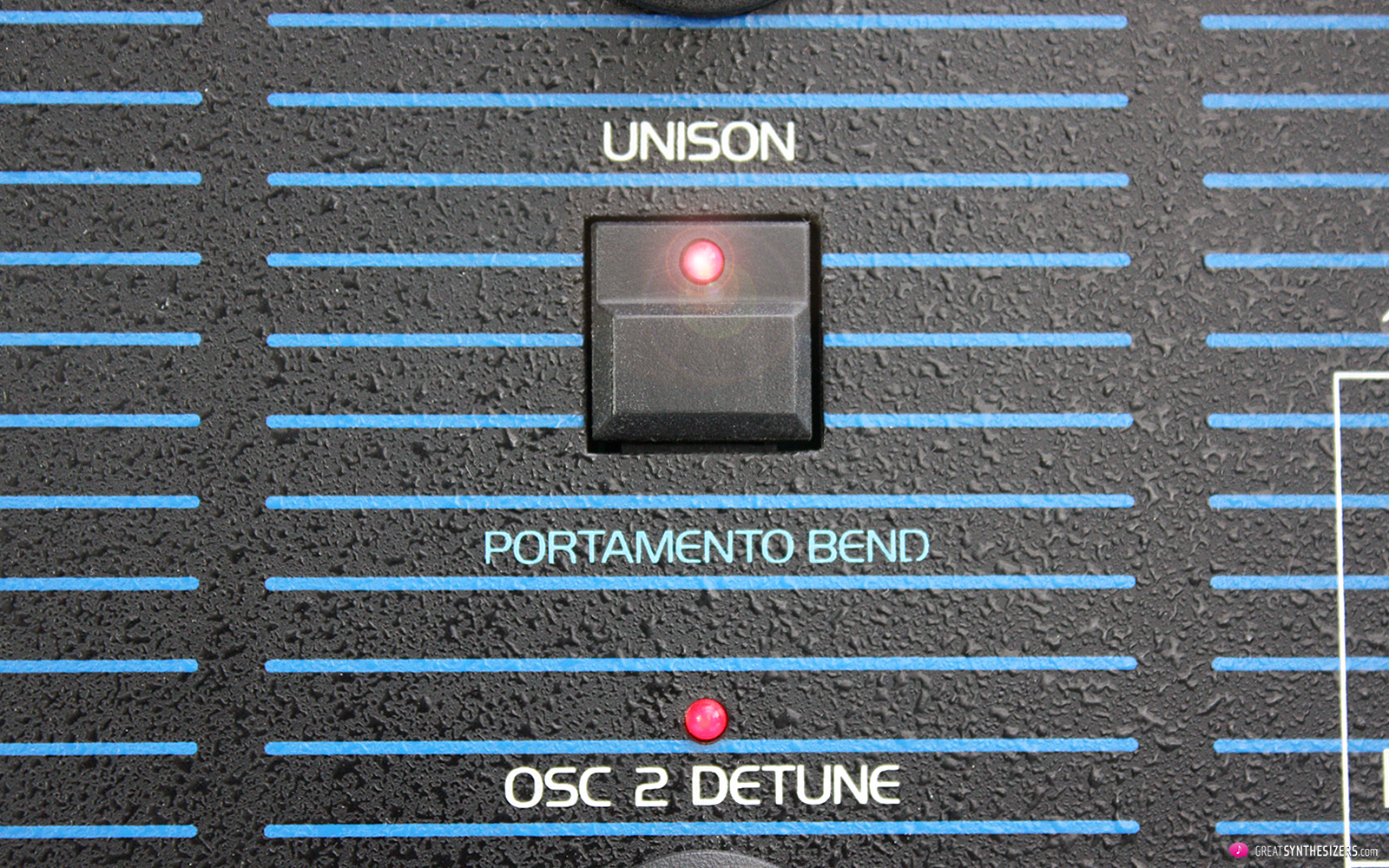

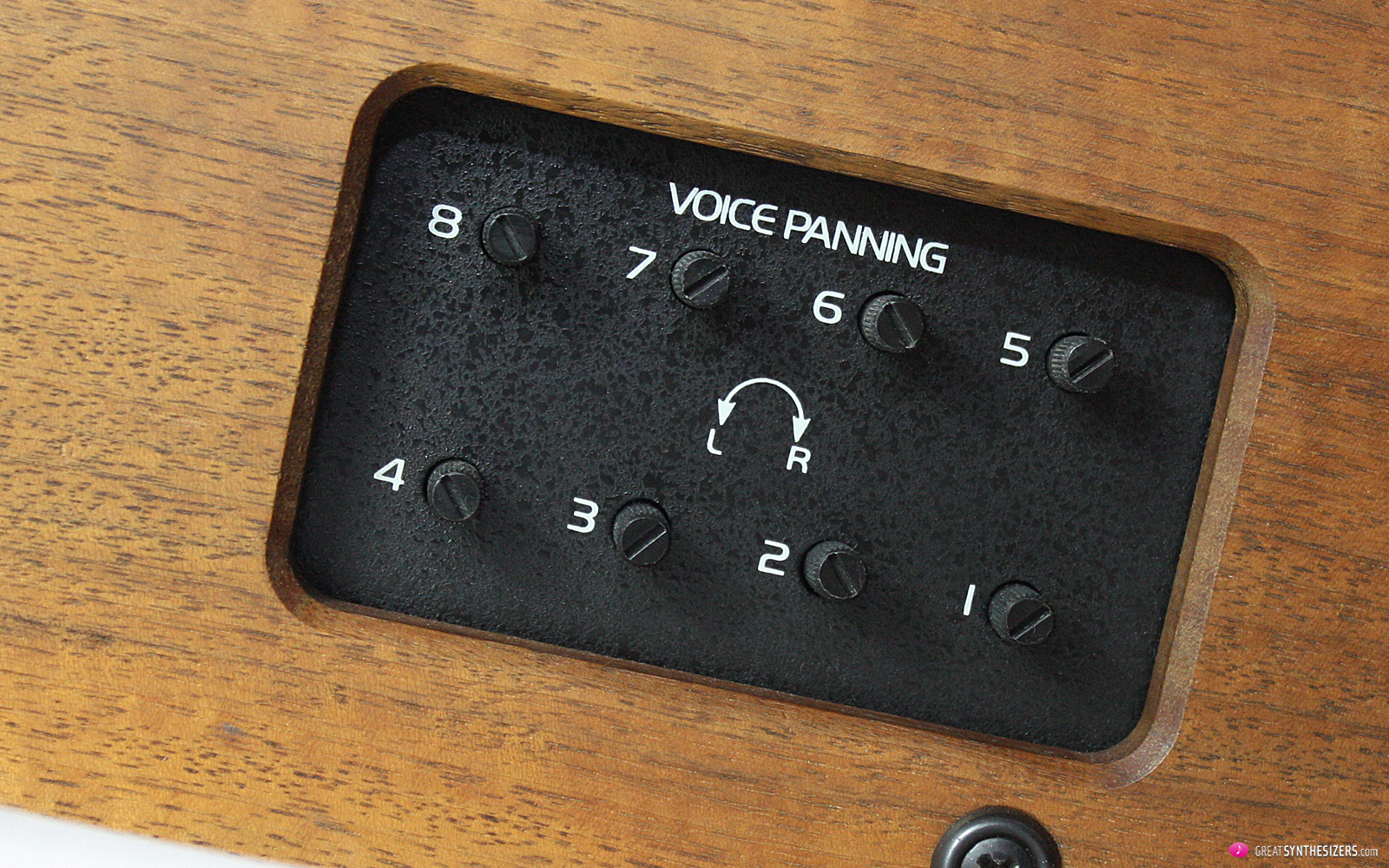
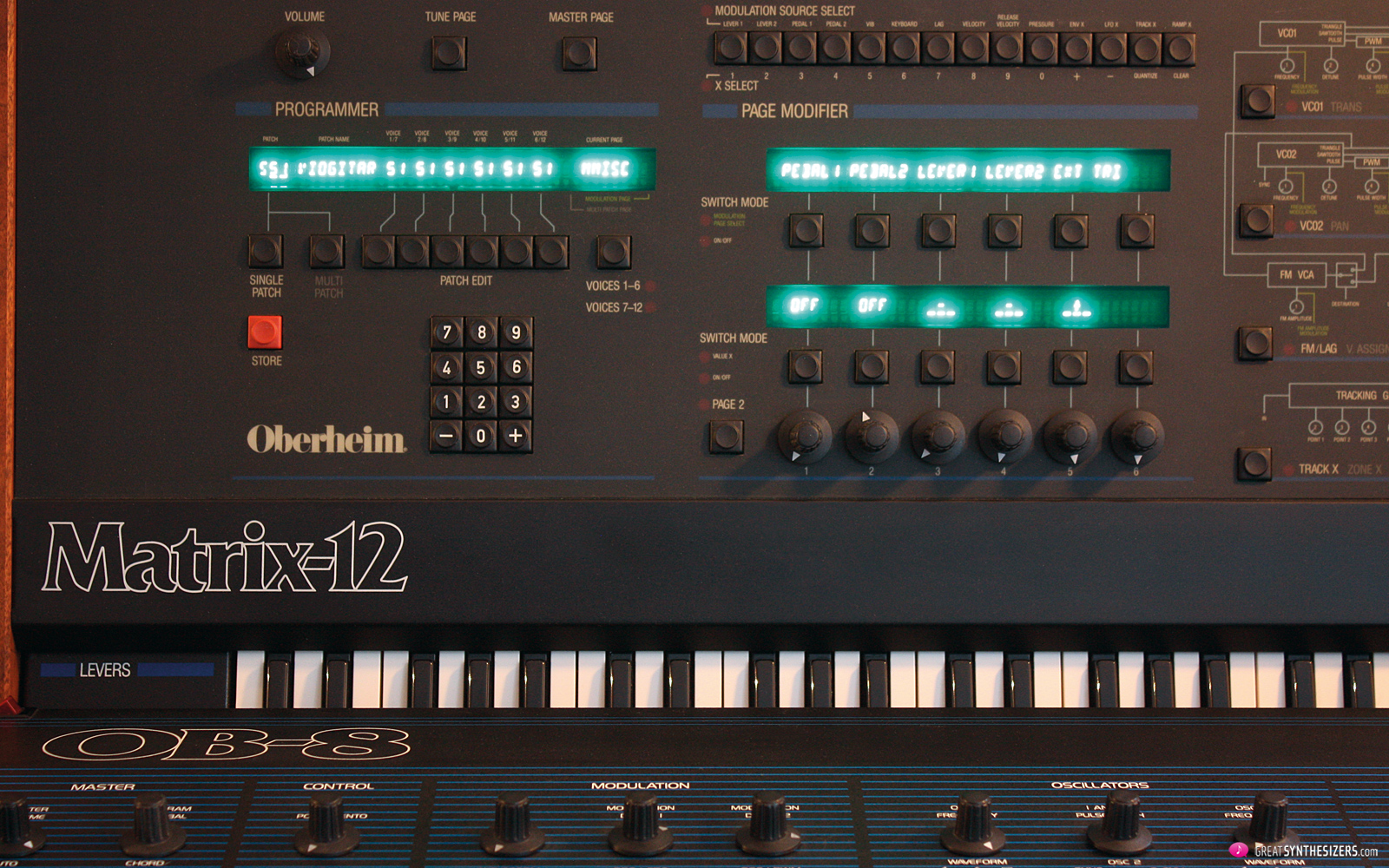

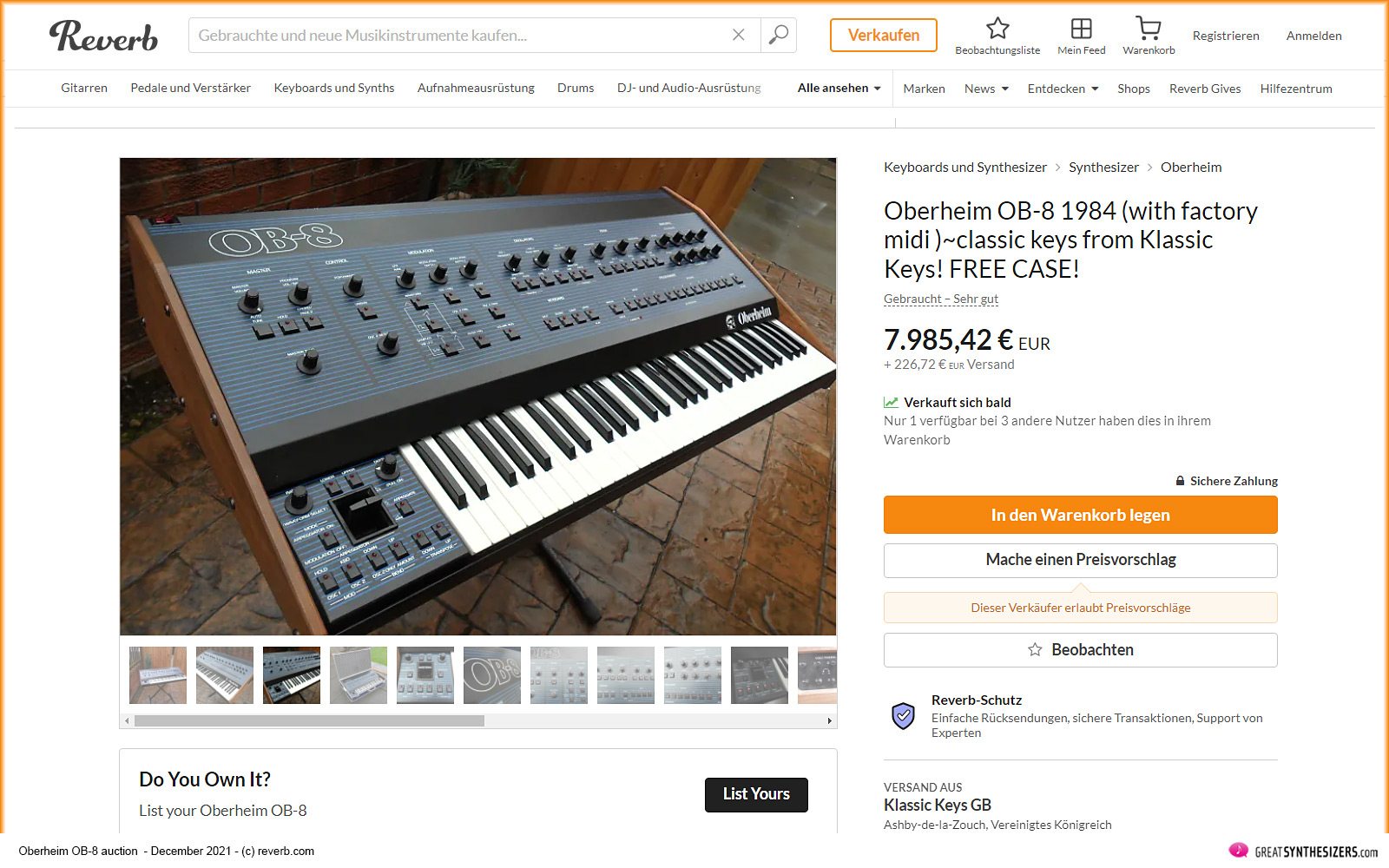
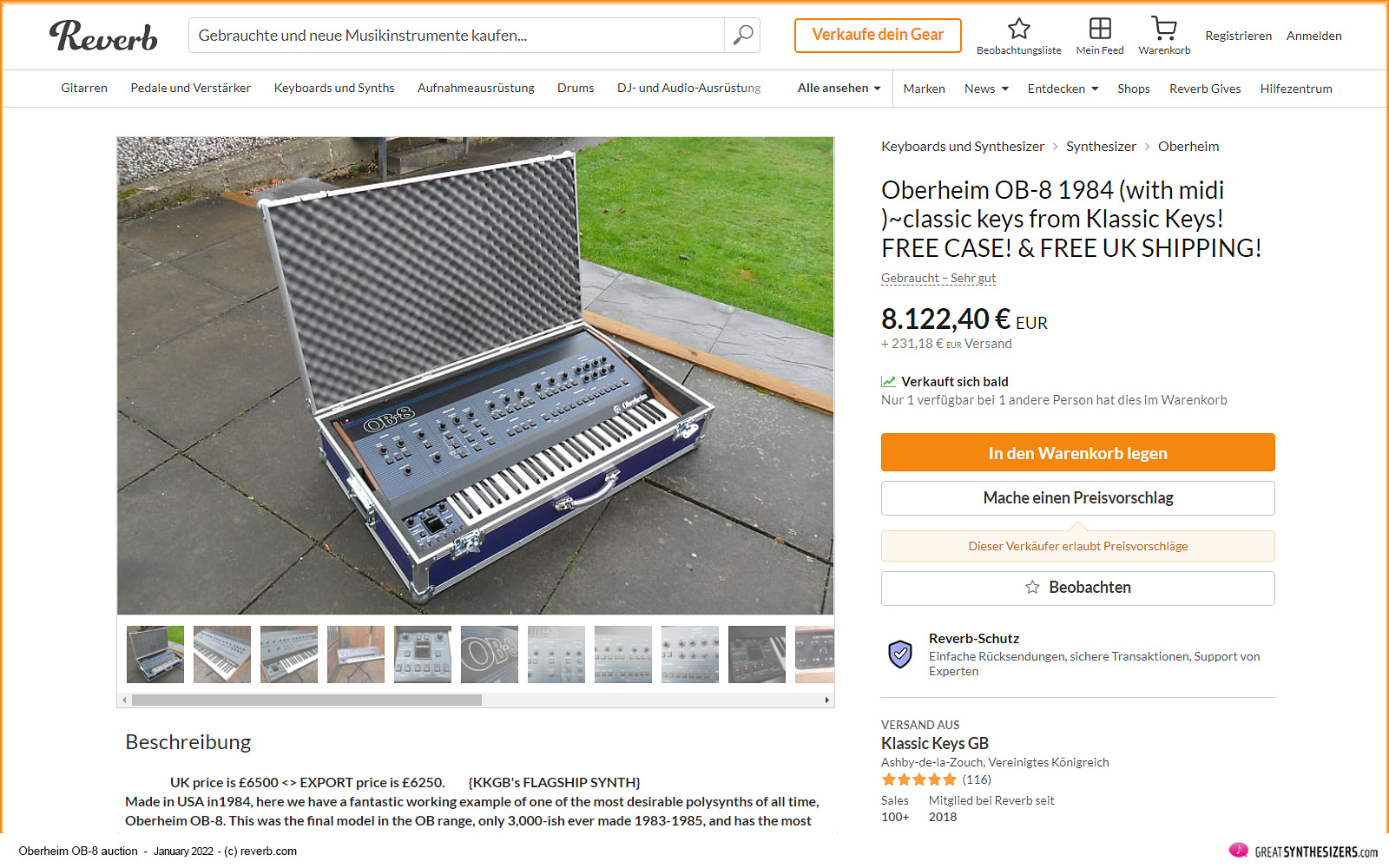
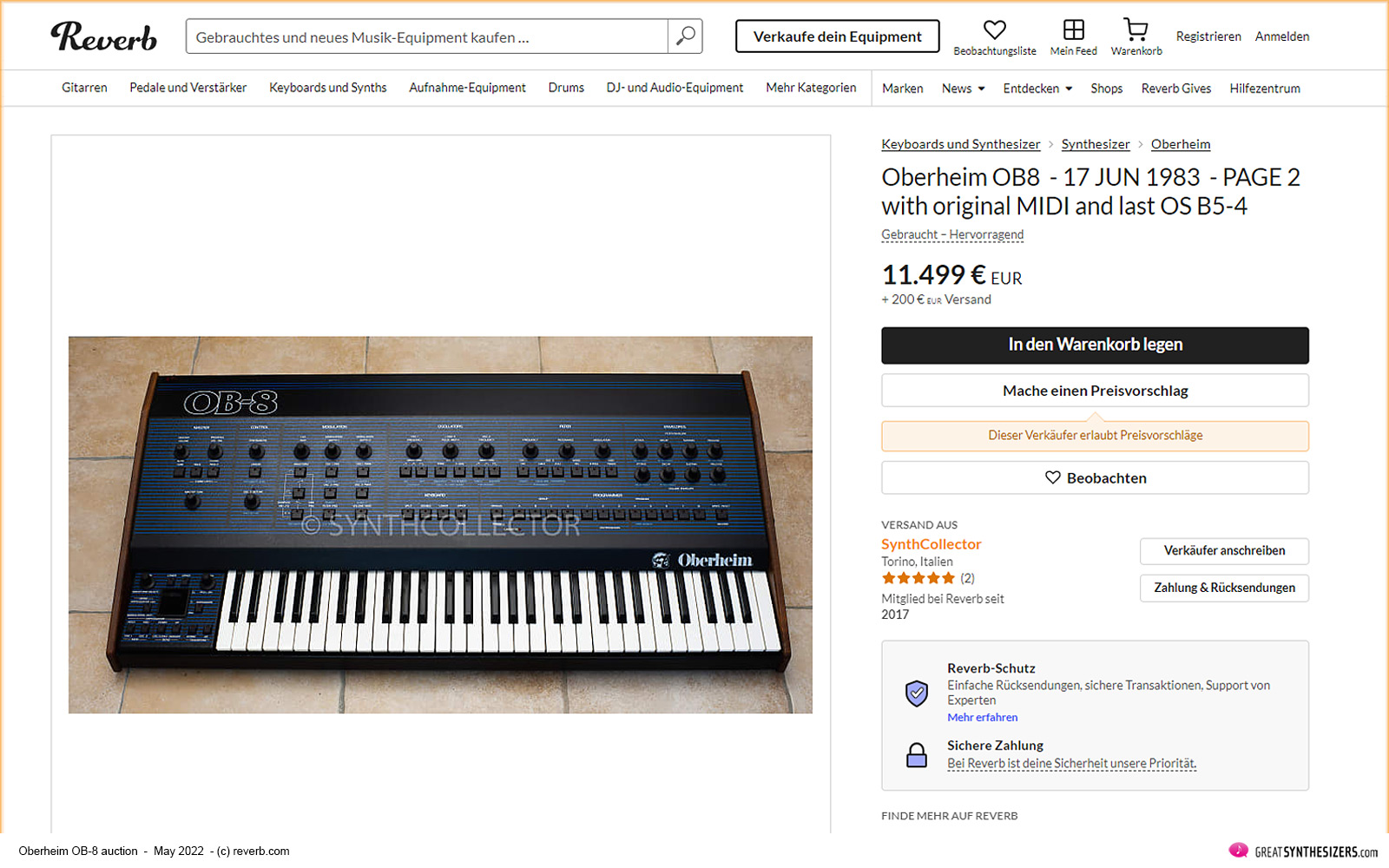


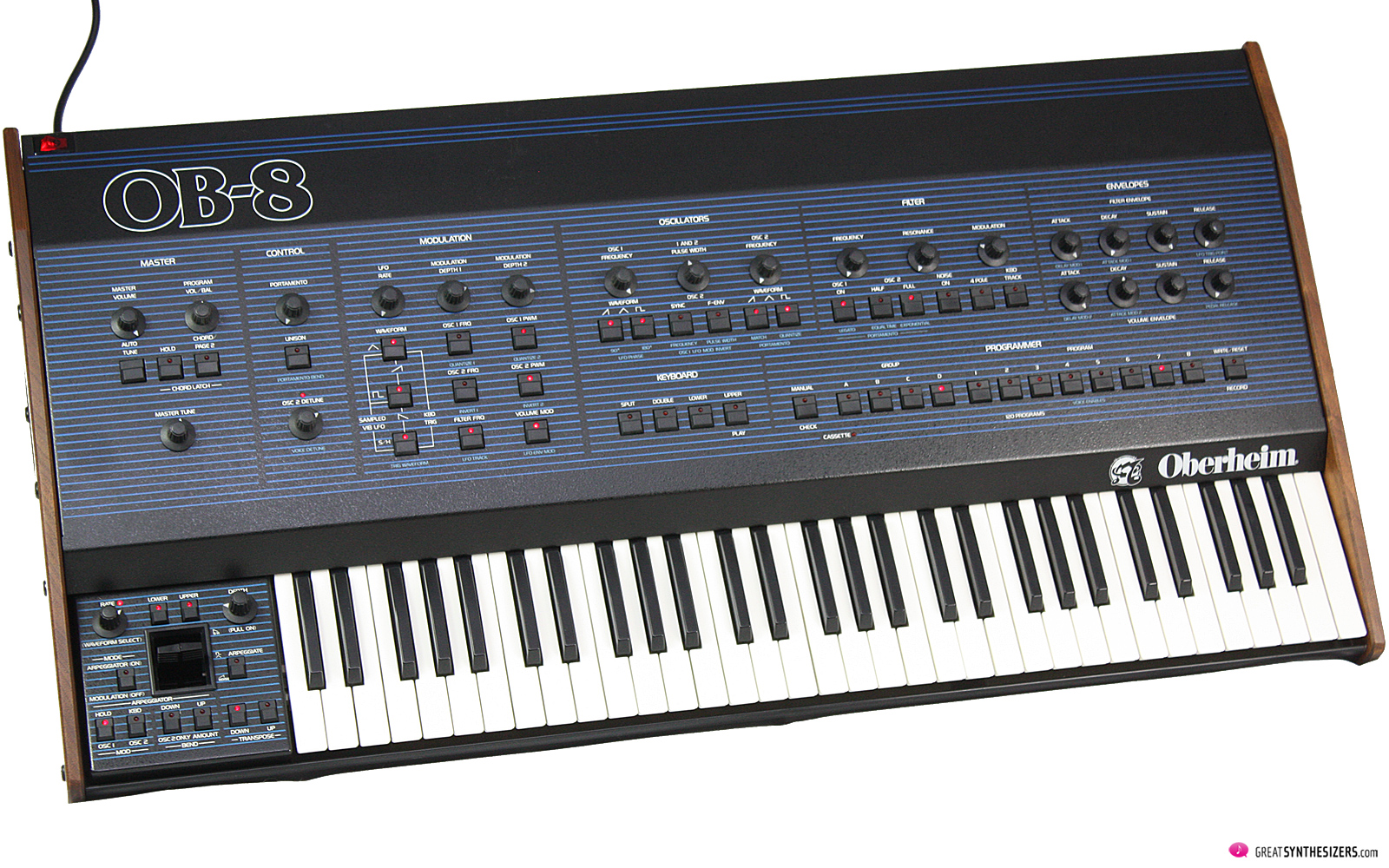
Damn, that must be one of your greatest set of demo sound-files ever! Granted, the instrument is very nice, but listening to this I know one thing for sure : there’s obviously much more value in the skills of the programmer & musician than in the bare instrument…
… thanks (o:
I have an Elka synthex and a Jupiter 6 and I also would like to get a ob8. What’s your opinion on the ob8 complementing what I have. I really like the sound but I am not sure if it really justifies. I can get one for 3400e.
Love your articles .
Thanks
… hello Mike. I’d get the OB-8, if I was you. It completes your (analog) setup in many ways. Synthex is amazing, Jupiter-6 too. But they are both highly precise analog synths – powerful, yet a little sterile in sound. OB-8 is (completely) different. Its sonic character adds warmth and agility to your overall studio sound. It adds another level of “analog” to your music. Ok, ok … if you’re focusing on funky, razor-sharp sequencing / pattern music, the OB-8’s envelopes might be a bit too slow. This is not the first option when it comes to “synth pop”. But as a source of lush, warm – stereo panning – pad sounds, screaming sync-effects and killer unison sounds, the OB-8 is unsurpassed …
And … 3400 Euros is a bargain …
Regards,
Theo
Thank you soo much for your answer.
I tried it today, buying it tomorrow :)
Keep your articles coming.
Great write up on this monster of a synthesizer. I found this while trying to get a better understanding of page 2. Im curious as to why in the world the model we have has no light blue labels for page 2. As if it wasn’t confusing enough….
I don’t agree that Jupiter-6 or Synthex are highly precise analog synths. They belong to the same high-end category with the OB-8, in the terms of hardware/sound with a lot of modulations. They are classic (Analog) CEM vintage synths. Also I cannot compare the Jupiter-8 with the OB-8, because they have completely different architecture.
Hello Jonathan. Technically speaking, you are right. They belong – more or less – to the same classic polyphonic CEM synth category. From a musician’s point of view, though, Jupiter-6 / Jupiter-8 (late version) / Synthex sound a lot more precise than any synth of the OB-series. Their tuning is really stable, their oscillators drift only little.
Soundwise, I’d put OB-X/Xa/8 in the same class as the Prophet-5 and Memorymoog. They all have that big, vibrant sound that stands for in-depth “classic analog” …
Sure, evaluation of synthesizers and their individual sound depends on your very own musical needs. So there are many different point of views … thankfully.
Regards,
Theo
Theo’s right on the money here. No denying it. Jupiter 6 is extremely sterile/cold for a VCO analog synth. The OB-6 sounds more vintage and VCO than the Jupiter 6 lol! What does sound different is the old VCAs, esp in Rolands, had this really nice rounded and weight tone that counter-acted their more sterile sound (even the DCO synths). It still never made them as alive/organic and warm as the OBies though!
I also agree w/ Theo 100%, as do many who have had the opportunity to work deeply w/ all the vintage polys discussed. The JP-8 and Synthex have complex calculated autotunes – and it results in a much more sterile sound. The JP-8 is still a great synth but the price is high because of its looks vs it’s sound. In fact I don’t even own one anymore I sold my last one in 2002, while I still have all 3 vintage oberheims, chroma, JP-4, and P5. As for the JP-6 forget it – you’re much better off with a modern sequential poly. The OB-8 is awesome and quite a bit more reliable tha earlier models. While I would keep the OB-X first I would keep the OB-8 before the OB-Xa.
Hi Theo, were the sound examples created with an OB-8 that’s had the Haible mods done to it? They sound really good!